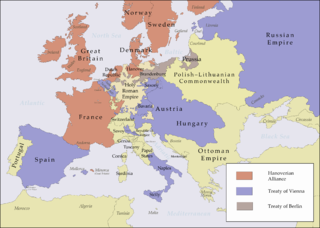This article needs additional citations for verification .(February 2024) |
| |||
|---|---|---|---|
| Buildings and structures +... |
The year 1725 in architecture involved some significant events.
This article needs additional citations for verification .(February 2024) |
| |||
|---|---|---|---|
| Buildings and structures +... |
The year 1725 in architecture involved some significant events.


1725 (MDCCXXV) was a common year starting on Monday of the Gregorian calendar and a common year starting on Friday of the Julian calendar, the 1725th year of the Common Era (CE) and Anno Domini (AD) designations, the 725th year of the 2nd millennium, the 25th year of the 18th century, and the 6th year of the 1720s decade. As of the start of 1725, the Gregorian calendar was 11 days ahead of the Julian calendar, which remained in localized use until 1923.

Baroque architecture is a highly decorative and theatrical style which appeared in Italy in the early 17th century and gradually spread across Europe. It was originally introduced by the Catholic Church, particularly by the Jesuits, as a means to combat the Reformation and the Protestant church with a new architecture that inspired surprise and awe. It reached its peak in the High Baroque (1625–1675), when it was used in churches and palaces in Italy, Spain, Portugal, France, Bavaria and Austria. In the Late Baroque period (1675–1750), it reached as far as Russia, the Ottoman Empire and the Spanish and Portuguese colonies in Latin America. In about 1730, an even more elaborately decorative variant called Rococo appeared and flourished in Central Europe.

Benito Pérez Galdós was a Spanish realist novelist. He was a leading literary figure in 19th-century Spain, and some scholars consider him second only to Miguel de Cervantes in stature as a Spanish novelist.

Estadio Benito Villamarín is a stadium in Seville, Spain, and the home of Real Betis since its completion in 1929. It has a capacity of 60,721.

Churrigueresque, also but less commonly "Ultra Baroque", refers to a Spanish Baroque style of elaborate sculptural architectural ornament which emerged as a manner of stucco decoration in Spain in the late 17th century and was used until about 1750, marked by extreme, expressive and florid decorative detailing, normally found above the entrance on the main façade of a building.
The Churriguera family consisted of at least two generations of Spanish sculptors and architects, originally from Barcelona, but who had their greatest impact in Salamanca. The highly decorated Churrigueresque style of architectural construction is named after the family.
The year 1770 in architecture involved some significant events.
Events from the year 1665 in art.

José Benito de Churriguera was a Spanish architect, sculptor and urbanist of the late-Baroque or Rococo style. He was born in Madrid to a Catalan cabinetmaker, gilder and altarpiece joiner, Josep Simó Xoriguera i Elies and to doña Maria de Ocaña, and studied under his father along with two of his brothers.

Ventura Rodríguez Tizón was a Spanish architect and artist. Born at Ciempozuelos, Rodríguez was the son of a bricklayer. In 1727, he collaborated with his father in the work at the Royal Palace of Aranjuez.
Events from the year 1725 in art.

The Real Academia de Bellas Artes de San Fernando, located on the Calle de Alcalá in the centre of Madrid, currently functions as a museum and gallery. A public law corporation, it is integrated together with other Spanish royal academies in the Instituto de España.

The Church of Saint Cajetan, known as the church of San Millán y San Cayetano is a Baroque church in Madrid, Spain.

Pedro de Ribera was a Spanish architect of the Baroque period.

The Convento de San Esteban is a Dominican monastery of Plateresque style, situated in the Plaza del Concilio de Trento in Salamanca, Castile and León, Spain.

The Plaza Mayor is a large plaza located in the center of Salamanca, Spain used as a public square. It was built in the traditional Spanish baroque style and is a popular gathering area. It is lined by restaurants, ice cream parlors, tourist shops, jewelry stores and a pharmacy along its perimeter except in front of the city hall. It is considered the heart of Salamanca and is widely regarded as one of the most beautiful plazas in Spain. It is connected to the shopping area Calle del Toro from the northeast, Calle de Zamora from the north, the restaurants on Calle de Concejo from the northwest, Calle del Prior and the small Calle de la Caja de Ahorros from the west as well as Plaza del Corrillo from the south.

Pablo González Velázquez (1664–1727) was a Spanish Baroque sculptor.

The defunct Convento de Santo Tomás was a set of buildings belonging to the Dominicans, under the patronage of St. Thomas Aquinas, in Madrid.

Ephemeral architecture had a special relevance in the Spanish Baroque, as it fulfilled diverse aesthetic, political, religious and social functions. On the one hand, it was an indispensable component of support for architectural achievements, carried out in a perishable and transitory way, which allowed a cheapening of materials and a way to capture new designs and more daring and original solutions of the new Baroque style, which could not be done in conventional constructions. On the other hand, its volubility made possible the creation of a wide range of productions designed according to their diverse functionality: triumphal arches for the reception of kings and aristocratic personages, catafalques for religious ceremonies, burial mounds for funerary ceremonies and diverse scenarios for social or religious events, such as the feast of Corpus Christi or Holy Week.